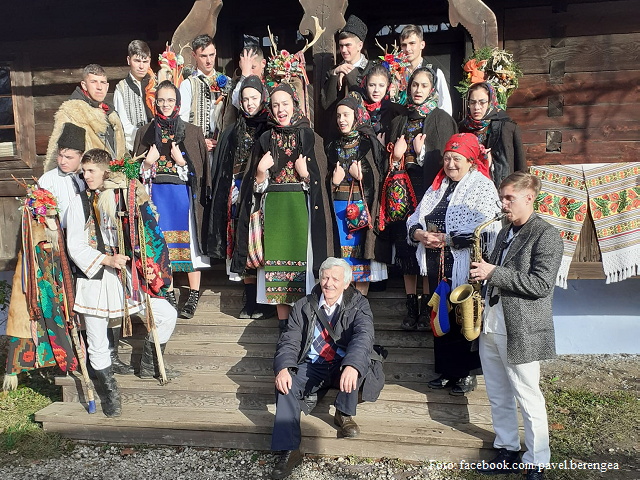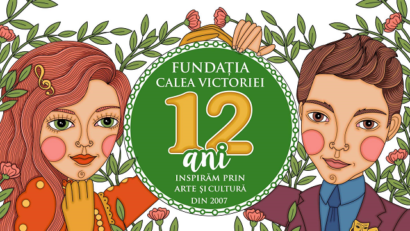Romanian Traditional Holidays
The taste of holidays with carolers, traditional products, and the scent of the hearth is still attractive

Ana-Maria Cononovici, 22.12.2022, 01:15
Happy New Year! The taste of holidays with carolers, traditional products, and the scent of the hearth is still attractive. Starting on December 24, Romanian homes are open to carolers and guests with a decorated Christmas tree, with either the latest fashion in decorations, or traditionally.
Let us look at some traditions in Romanian villages in the Christmas and New Year period, in areas that still hold on tight to old traditions.
We spoke first to Pavel Berenghea, leader of the Cununita music group in Ilva Mare, in Bistrita-Nasaud County, after they presented a traditional theater moment at the Dimitrie Gusti National Village Museum in Bucharest:
“Today we presented a tradition from our area, the Goat Dance, but it is called Belciugarii since the days of our forefathers, it is a rendition of this tradition held in winter and summer, because the summer was the time when our traditional shepherds took the sheep up the mountain for pasture, in Rodnei Mountains. In autumn they resume this custom, at the time for sheep to come back. It shows a shepherd, the protagonist, who takes care of goats, then a bear comes to attack the goats, which get defended by the shepherd. We also have another shepherd who plays the traditional flute, which is now replaced by a clarinet or a saxophone, which are modern instruments. We present this custom all over the country, but also abroad, sometimes Paris. It is beautiful, and very much appreciated. It is appreciated for its nice rhythm, which is different from other goat dances in other parts of the country. We have a very special rhythm where we are from, in Ilva Mare. We have 20 members of the team, dancers and carolers, dressed beautifully in old time clothes. We love presenting and perpetuating these costumes, these traditions and customs.
Next we went to Tulcea, to listen to the crowd of Mosoaie carolers, sung accompanied by the rhythm of jingle bells and the dance, who are masked with hollowed out pumpkins that scare away the evil spirits. Here with details is teacher and dance master Ion Trandafir, the elderly guide of the carolers:
“Mosoaiele, in Luncavita de Tulcea, have great importance, starting on St. Nicholas day and up until the Baptism of the Lord. Mosoaiele are unique to our area. The Mosoaie have a specific costume, which on Christmas Eve reminds householders to clean their yards, and also chases away evil spirits. Christmas has to be evil spirit free. When the villagers hear the bells, they open their gates. If a host turns away carolers, they will not enjoy Christmas. There are many groups of carolers, and each villager can get two or three. This Mosoaie celebration is attended by almost 50 carolers.
And since the area is also inhabited by Turks and Tatars, on the Mosoaie they receive the carolers in their homes, and Romanians bake baklava.
In Transylvania, Christmas preparations begin on November 15, when fasting begins. That is when people stop work in the field, stop eating meat, and women meet in groups to make the holiday clothing. Maria Ana Miris, dressed very smartly in traditional clothes from the Cluj area, told us about traditions there:
“People go caroling on the birthday of the Saviour, and we also have pre-Christian carols, such as the Caroling of Youth, with songs specific to our areas. We don’t wear masks, we don’t wear special clothes, just traditional ones. The carolers are eagerly awaited.
For New Year’s Eve, in traditional villages, but also in cities, they keep the tradition of going from door to door, gate to gate, caroling and performing ancient rituals. The Sorcova, the Little Plough, the Goat, or the Bear Dance are just some of the beautiful and very old customs.
In Bukovina villages, masked carolers go around the homes in a group that consists of masked characters, such as the bear, goat, deer, the beautiful, the ugly, the devils, the doctors, or the bear handlers.
The Bear Traveling Dance is specific to Moldavia on New Year’s Eve. The bear is played by a young man wearing on his head and shoulders the fur of a bear, adorned with red tassels around the ears. He is driven by a bear handler, accompanied by musicians, followed by a procession of characters, among them a child playing the bear cub. Banging on drums and blowing into flutes, helped by the pacing of a staff, the masked bear grunts and imitates the gait of a bear, stomping the ground. It is meant to purify and fertilize the soil for the new year. It is believed that this custom goes back to the ancient Dacians.
The first day of the new year is a time for the Little Plough and the Sorcova, which are also rituals to bring prosperity and wealth for the household that receives the carolers. It is said that refusing them would bring sorrow and poverty in the new year.






























